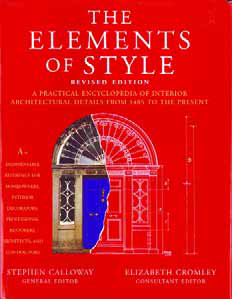characteristics
When people ask me how I approach the design process, I tell them it's always based on three things: The clients' ideas about what they want; the site's characteristics; and the architecture of the home. If I had to pick one of those factors that's been the most challenging for me to master, I'd have to say it's been gaining a firm grasp on architecture and the details that make up architectural styles. And when I've been asked where that kind of background can be gained in the form of a reference book, I've always been at something of a loss to make a recommendation. Basically, it's tough to narrow things down because architectural design is so huge a topic. Without an architect's educational background and training, I've been left to pick up what I can mostly by paying attention to what I see around me - a challenge in itself in my area, where most
When people ask me how I approach the design process, I tell them it's always based on three things: The clients' ideas about what they want; the site's characteristics; and the architecture of the home. If I had to pick one of those factors that's been the most challenging for me to master, I'd have to say it's been gaining a firm grasp on architecture and the details that make up architectural styles. And when I've been asked where that kind of background can be gained in the form of a reference book, I've always been at something of a loss to make a recommendation. Basically, it's tough to narrow things down because architectural design is so huge a topic. Without an architect's educational background and training, I've been left to pick up what I can mostly by paying attention to what I see around me - a challenge in itself in my area, where most
In one form or another, almost every landscape project uses stone. Whether it's ledger, rubble, pebbles or flagstone - on its own or woven into other hardscape materials - when it comes to shaping exterior environments, stone is one of the most versatile of all materials at your disposal. In my experience as a stone supplier, however, few landshapers understand enough about the properties and characteristics of available stone products to use them as effectively as possible. This is true despite the fact that inappropriate stone usage creates liabilities for both the installer and the client and that the need for eventual replacement incurs great cost down the line. Simply knowing which types of stone are dense and which are soft, for example, is enough to prevent many problems with installations and will make landscapes more successful. While placing beautiful slate on an exterior deck may seem a great idea visually, for instance, it will eventually disintegrate as a result of exposure to the elements, nobody involved will be happy - and everybody will recognize that it would have been better to
In one form or another, almost every landscape project uses stone. Whether it's ledger, rubble, pebbles or flagstone - on its own or woven into other hardscape materials - when it comes to shaping exterior environments, stone is one of the most versatile of all materials at your disposal. In my experience as a stone supplier, however, few landshapers understand enough about the properties and characteristics of available stone products to use them as effectively as possible. This is true despite the fact that inappropriate stone usage creates liabilities for both the installer and the client and that the need for eventual replacement incurs great cost down the line. Simply knowing which types of stone are dense and which are soft, for example, is enough to prevent many problems with installations and will make landscapes more successful. While placing beautiful slate on an exterior deck may seem a great idea visually, for instance, it will eventually disintegrate as a result of exposure to the elements, nobody involved will be happy - and everybody will recognize that it would have been better to
One of the fascinating things about working with the different types of clients we encounter as watershapers is that we can never really know what to expect. If my years of experience have taught me anything, it's that perception is often very different from reality. Instead, what I find is that the basic assumptions we might be inclined to make about different "categories" of clients are, often as not, completely confounded by the uniqueness of every situation. As a result, working effectively across a range of project types and client economic levels means being able to withhold judgment or at the very least avoid
One of the fascinating things about working with the different types of clients we encounter as watershapers is that we can never really know what to expect. If my years of experience have taught me anything, it's that perception is often very different from reality. Instead, what I find is that the basic assumptions we might be inclined to make about different "categories" of clients are, often as not, completely confounded by the uniqueness of every situation. As a result, working effectively across a range of project types and client economic levels means being able to withhold judgment or at the very least avoid















